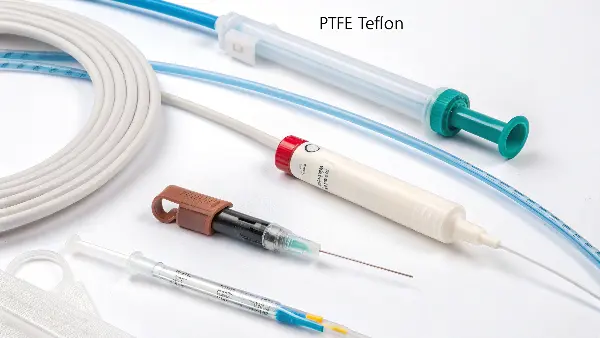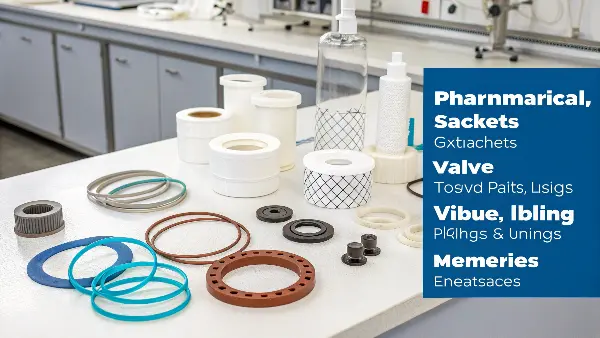Need a material for extreme conditions? PTFE seems ideal, but where is its unique combination of properties truly indispensable? Finding the right fit is crucial for success.
PTFE excels in demanding aerospace, medical, and pharmaceutical applications due to its high-temperature resistance1, chemical inertness2, low friction, and biocompatibility3. It’s used for seals, gaskets, wire insulation, tubing, bearings, medical implants, and non-stick surfaces where reliability is paramount.
PTFE, often known by the brand name Teflon, isn’t just for non-stick pans. Its unique properties make it a go-to material when failure is not an option. From thousands of feet in the air to inside the human body, its reliability is proven. Let’s explore exactly where and why it’s so critical in these demanding fields.
What are the Applications of PTFE in Aerospace?
Designing aircraft or spacecraft means facing extreme temperatures, harsh chemicals, and needing low friction. Choosing the wrong material here can lead to catastrophic failure under these demanding operational conditions, putting safety and mission success at risk.
In aerospace, PTFE is vital for wire and cable insulation (especially in harsh environments), seals and gaskets for fuel and hydraulic systems, low-friction bearings, protective coatings, and flexible conduits due to its thermal stability, chemical resistance, and lubricity.
Let’s delve deeper into why PTFE is indispensable in the skies and beyond. The aerospace industry pushes materials to their limits, and PTFE consistently meets these challenges. I remember working on a project supplying components for a new aircraft; the stringent material specifications almost always led back to fluoropolymers, particularly PTFE for certain critical spots.
- ### Wire and Cable Insulation:
- Aerospace wiring often routes through areas with high temperatures (near engines) or exposure to aggressive fluids (fuel, hydraulic oil). PTFE insulation offers excellent thermal resistance (typically up to 260°C / 500°F) and is virtually inert to these chemicals.
- It also has excellent dielectric properties (it’s a great electrical insulator) and doesn’t easily burn (high Limiting Oxygen Index). Thin PTFE insulation helps save weight and space, which are always critical factors in aircraft design. Tapes made from PTFE are also commonly used for wrapping wire harnesses.
- ### Seals, Gaskets, and Fluid Handling:
- Systems carrying fuel, hydraulic fluids, or coolants require seals that won’t degrade upon contact. PTFE’s broad chemical resistance makes it ideal for O-rings, gaskets, and valve seats in these systems.
- Its performance across a wide temperature range ensures sealing integrity from cold high altitudes to hot engine compartments. Filled PTFE grades (e.g., with glass or carbon) are often used to improve wear resistance and reduce creep under load in sealing applications.
- ### Low-Friction Bearings and Surfaces:
- PTFE has one of the lowest coefficients of friction of any solid material. This makes it suitable for bearings, slide plates, and bushings where low friction is needed without lubrication, or where lubricants might fail at extreme temperatures. Think about control surface linkages or landing gear components.
- ### Protective Coatings:
-
PTFE coatings can be applied to various components to provide corrosion resistance, non-stick properties (e.g., for ice release), or chemical protection. Aerospace Requirement Relevant PTFE Property Specific Application Examples High Temperature Excellent Thermal Stability (~260°C) Wire Insulation near engines, Hot fluid seals Chemical Exposure Exceptional Chemical Inertness Fuel/Hydraulic Seals, Gaskets, Valve Seats Low Friction Needed Very Low Coefficient of Friction Bearings, Bushings, Slide Plates Electrical Insulation High Dielectric Strength Wire & Cable Insulation, Connector Insulators Weight/Space Saving Can be used in thin sections/coatings Thin-wall wire insulation, Compact seals Fire Safety High LOI, Low Flammability Wire Insulation, Cabin components The combination of these properties makes PTFE a reliable choice for ensuring performance and safety in the demanding aerospace environment.
What are the Applications of PTFE in Medical Devices?
Developing medical devices requires materials that are safe, reliable, and often interact directly with the human body or sensitive fluids. Using a non-biocompatible or reactive material can have serious health consequences for patients and lead to device failure.
-
PTFE (often known by the brand name Teflon) is used in medical devices for implants like vascular grafts4, surgical patches, catheters, guidewire coatings, tubing for fluid handling, and non-stick surfaces on surgical tools due to its exceptional biocompatibility5, chemical inertness, and lubricity.

The medical field demands the highest standards for materials, especially those used inside the body. PTFE’s unique characteristics make it suitable for applications where interaction with biological tissues and fluids is necessary. I’ve seen firsthand how material selection is scrutinized in medical device design – biocompatibility testing is rigorous.
- ### Biocompatibility and Inertness:
- One of PTFE’s most significant advantages in medicine is its excellent biocompatibility. It generally does not cause adverse reactions when implanted or in contact with body tissues and fluids (often meets USP Class VI standards).
- Its chemical inertness means it doesn’t react with or degrade when exposed to bodily fluids, medications, or sterilization processes.
- ### Implants:
- A modified form, expanded PTFE (ePTFE), has a microporous structure that allows for tissue ingrowth. This makes it valuable for vascular grafts (artificial blood vessels), surgical patches for tissue repair (like hernia repair), and even sutures. Pure PTFE can also be used in components for heart valves or other implants.
- ### Catheters and Guidewires:
- PTFE’s extremely low coefficient of friction (lubricity) is critical for catheters and guidewires. Thin PTFE coatings on guidewires or inner linings in catheter lumens allow them to slide smoothly through blood vessels or other body passageways with minimal trauma. This makes procedures easier for doctors and safer for patients. PTFE tubing is also used directly for fluid delivery.
- ### Surgical Tools and Equipment:
- Non-stick PTFE coatings are applied to electrosurgical instruments to prevent tissue sticking and buildup during procedures, making them easier to clean and maintain sterility. Components in diagnostic equipment might also use PTFE for chemical resistance or low friction.
- ### Sterilization Compatibility:
-
PTFE can withstand common medical sterilization methods, including autoclaving (steam), ethylene oxide (EtO), and gamma radiation, without significant degradation of its key properties. Medical Requirement Relevant PTFE Property Specific Application Examples Direct Tissue Contact Excellent Biocompatibility (USP Class VI) Vascular Grafts (ePTFE), Surgical Patches, Sutures Fluid/Drug Contact Chemical Inertness Catheter Tubing, Fluid Transfer Lines, Valve Components Ease of Insertion Very Low Coefficient of Friction Catheter Liners/Coats, Guidewire Coatings Prevent Sticking Non-stick Surface Coatings on Electrosurgical Tools Sterilizability Withstands Autoclave, EtO, Gamma Reusable Instruments, Implantable Devices The trust placed in PTFE within the medical device industry stems directly from its unique blend of inertness, lubricity, and proven compatibility with the human body.
What is PTFE Used For in the Pharmaceutical Industry?
Ensuring product purity and preventing contamination is absolutely critical in pharmaceutical manufacturing. Equipment materials must not react with potent drugs or leach unwanted substances, as this could compromise product safety, efficacy, and regulatory compliance.
-
In the pharmaceutical industry, PTFE is used for seals, gaskets, valve components, tubing, vessel linings, and filter membranes. Its chemical inertness prevents reaction with active pharmaceutical ingredients (APIs), and its non-stick surface aids in cleanability and prevents cross-contamination.

Maintaining purity throughout the drug manufacturing process is paramount. PTFE plays a key role because it resists reacting with the wide range of chemicals used and helps keep equipment clean. Having supplied components to pharma companies, I know their validation processes for materials are incredibly thorough – PTFE often passes where other materials fail.
- ### Chemical Inertness and Purity:
- Pharmaceutical processes involve diverse and often aggressive chemicals, including solvents, acids, bases, and the Active Pharmaceutical Ingredients (APIs) themselves. PTFE’s exceptional chemical resistance ensures it won’t corrode, degrade, or leach contaminants into the product stream. This is vital for maintaining drug purity and stability.
- ### Non-Stick Surfaces and Cleanability:
- PTFE’s non-stick properties are highly beneficial. They minimize product buildup on equipment surfaces like tanks, pipes, and valves. This reduces product loss and, crucially, makes cleaning processes (like Clean-in-Place, CIP, and Sterilize-in-Place, SIP) much more effective, reducing the risk of cross-contamination between different batches or products.
- ### Seals, Gaskets, and Valve Components:
- Reliable sealing is essential to prevent leaks and maintain containment. PTFE is widely used for O-rings, gaskets, valve seats, diaphragms (in diaphragm valves common in pharma), and pump components due to its chemical resistance and ability to create effective seals. Modified or filled PTFE grades enhance mechanical properties for demanding sealing applications.
- ### Tubing and Linings:
- PTFE tubing is used for transferring high-purity fluids or aggressive chemicals. Larger vessels or pipes might be lined with PTFE to provide a non-reactive, easy-to-clean surface without the cost of making the entire vessel from a more exotic metal.
- ### Filtration:
-
PTFE membranes, often in expanded (ePTFE) form, are used for filtration, particularly for venting applications or filtering aggressive solvents. Its hydrophobic nature (water-repelling) is useful in specific separation processes. Pharmaceutical Need Relevant PTFE Property Specific Application Examples Product Purity Extreme Chemical Inertness Vessel Linings, Tubing, Valve Seats, Seals (Non-leaching) Prevent Contamination Non-stick Surface, Cleanability Tank Linings, Mixer Blades, Tubing, Valve Diaphragms Aggressive Chemicals Broad Chemical Resistance Handling Solvents, Acids, Bases, APIs Containment Good Sealing Properties Gaskets, O-rings, Valve Seals, Pump Components High/Low Temperature Wide Service Temperature Range Compatibility with Steam Sterilization (SIP), Cold processes Filtration/Venting Porosity (ePTFE), Hydrophobic Sterile Vent Filters, Solvent Filtration In pharmaceutical manufacturing, where product integrity is non-negotiable, PTFE’s inertness, cleanability, and resilience make it an essential material for building safe and efficient processes.
Conclusion
From the extreme demands of aerospace to the critical safety needs of medical implants and pharmaceutical purity, PTFE’s unique combination of properties makes it invaluable. Its reliability in these demanding applications underscores its importance across advanced engineering sectors.
-
-
Understanding high-temperature resistance applications can help you see where PTFE is crucial in extreme conditions. ↩
-
Exploring the importance of chemical inertness will highlight PTFE’s role in safety and reliability in critical environments. ↩
-
Learning about biocompatibility can reveal why PTFE is essential for medical implants and devices, ensuring patient safety. ↩
-
Learn about vascular grafts, their applications, and the materials used, which are vital for successful surgical outcomes. ↩
-
Understanding biocompatibility is essential for ensuring patient safety and device effectiveness in medical applications. ↩


